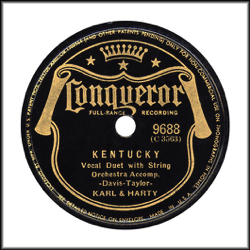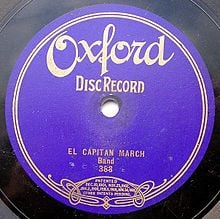Tag: Sears
Conqueror Record Label

Conqueror Record Label
Produced from 1926-March 1942 exclusively for Sears at a price of 39 cents. Designed as an expensive label to complement the Silvertone, Supertone, and Challenge labels. Pressed by Regal Record Company from 1926-June 1929 and then pressed American Record Company (ARC) from 1929 onward. When ARC took over the pressing, they dropped all mention of Sears on the record.
The trumpeters were removed in 1934 and replaced by a simplified shield design. When ARC was bought by CBS in 1938, CBS kept the Conqueror label and packaged the label in sets. In the label’s final days (1938-1942) the Conqueror’s shield appeared as black rather than red. Many of Conqueror’s artists used pseudonyms and because Sears was at various times contracting three different record companies to produce music and those record companies often drew from the same catalogs or master records there is considerable duplication of music. However, some records may be alternate takes, and records produced after the 1938 acquisition tended to be artists from the CBS catalogs.
Music Genres: Country, Jazz, Blues, Swing, Pop.
Pre-WW2 Label: Red background with decorative rim and trumpeters.

From 1934-1938 the record label has a basic red shield without the trumpeters.
1941-1945 Label: After being bought by CBS, the label switched to being all-black.
Post-WW2 Label: None.
Numbers from start to 1945: 7000-10000. Numbers 7254-7277 are race and country artists.
Notes: Famous artists found on this record label include: Big Bill Broonzy, Lucille Bogan (aka: Bessie Jackson), Amos Easton aka Bumble Bee Slim, Lil Johnson, and Memphis Minnie. Other important artists include Louis Armstrong, Cab Calloway, and Gene Autry.
Listen to Dear Old Western Skies by Gene Autry on a 1934 Conqueror Record.
Listen to My Gage is going up by Memphis Minnie on a Conqueror Record most likely from the early 1930s.
Sources:
http://www.mainspringpress.com/sears-labels.html
Rust, Brian. The American Record Label Book. Arlington House Publishers, NY. 1978.
Sutton, Nauck. American Record Labels and Companies: An Encyclopedia (1891-1943). Mainspring Press, CO.2000.
Country Music Records: A Discography, 1921-1942
Challenge Records

Challenge Records by Sears
The Challenge record label was a budget label for Sears. It was produced from 1926-1930. It was pressed by the Starr Piano Company and would duplicate recordings found on Gennett and Champion records. Most were of anonymous recordings.
The Challenge Label sold for 24 cents and is generally of inferior quality. Starr struggled to produce records and, in its final years, Sears used The Scranton Button Company to press the records using master records from Plaza Music Company.
Music Genres: Waltz, orchestra, race records, blues, country, popular, reprints of Gennett and Champion records.
Pre-WW2 Label: This was the only label design for the record production: 1926-1930. Green and Gold with a Knight in Armor imagery. Note: Wikipedia for some reason has the record below but in black and white which is inaccurate.
1939-1945 Label: None by Sears
Post-WW2 Label: None by Sears.
Numbers from start to 1945: 101-810
The Challenge Label has an unknown number of recordings but the series consists of 3 digits.
101–271, 301–431, 501–506 = Gennett
532–698, 763–793, 811–999 = Plaza and successor American Record Corporation;
700–760 and 801–810 = Miscellaneous sources
Note: Many of the country artists were pseudonyms.
Sources:
http://www.mainspringpress.com/sears-labels.html
Country Music Records: A Discography, 1921-1942
Supertone Records

Supertone Records by Sears
Click the link to visit Supertone Records page as part of the 78 Records Project for World War II Reenactors.
Supertone Records
Silvertone Records

Silvertone Record Label (1916-1950) by Sears
Silvertone Records: For label discussion and analysis
Oxford Record Label

Oxford Record Label (1906-1916)
The Oxford Record Label was a Sears label that came after Sears’ discontinuation of their Harvard Label. They are single-sided and can be found as either a 7in. disc or a 10in. disc. At the start, Sears used Leeds and Catlin from 1906-1908 to produce the record, switched to Columbia from 1908-1909, then to Victor (using their Zon-o-phone masters) between 1909-1911, and then back to Columbia between 1911-1916. Indeed, Columbia continued to produce for Sears under the Oxford label a 7in. disc while Victor produced a 10in. disc. Recordings are mostly anonymous For an excellent review of the Oxford label see the sources below.
Music Genres: Waltz, Black or “Coon” music, Orchestra, Marches, Operettas.
Pre World War II Label: Purple with Oxford in a scripted style.
While not an Oxford Label it is an example of the Negro Laughing Song by George W. Johnson who was the first African-American to sing on a record.

Leg of Mutton Le Gigot, 1913.
Numbers to 1945: Columbia will switch to a new label called Silvertone in 1915/1916.
Harvard Record Labels

Harvard Record Labels (1905-1907)
Harvard Records was a 78 record label sold exclusively by Sears. Columbia Records originally produced the record. The catalog numbers were similar to Columbia master catalogs. The Harvard Record Label used anonymous recordings. The records came in either 7in. or 10in. sizes.
Music Genres: Waltz, Patriotic, Orchestra, Comedic, Folk Songs, Black or “Coon” songs. (The Harvard Record label and Sears sold music that exemplified the time. Such musical lyrics that stereotyped dialects would be unacceptable today)
Pre-1941 Label: Plan label with blue lettering.

Uncle Josh was the pseudonym for Cal Stewart, a vaudeville actor that made the transition into sound. He is known for comedic narratives. While not on a Harvard Disc the recording below is indicative of Cal’s comedic style.
Another example of the early Harvard Disc Record label.
Not on a Harvard Record label but it demonstrates what the duet sounded like. You can note the same catalog number as the Harvard disc above. This was due to the fact that Harvard pulled from the master catalog of Columbia. Indeed, it appears the Peerless Disc Record did as well.
The Harvard Record label went through a label re-design in late 1906 or early 1907. This new design featured a collegiate pennant and lettering in orange.
World War Two Label: None. The label did not exist
Sources:



